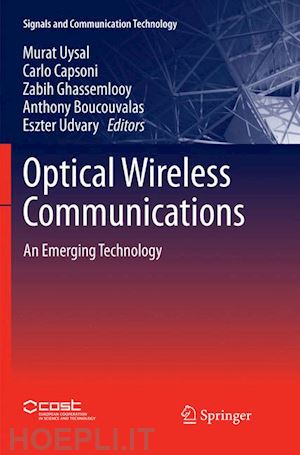
Questo prodotto usufruisce delle SPEDIZIONI GRATIS
selezionando l'opzione Corriere Veloce in fase di ordine.
Pagabile anche con Carta della cultura giovani e del merito, 18App Bonus Cultura e Carta del Docente
This book focuses on optical wireless communications (OWC), an emerging technology with huge potential for the provision of pervasive and reliable next-generation communications networks. It shows how the development of novel and efficient wireless technologies can contribute to a range of transmission links essential for the heterogeneous networks of the future to support various communications services and traffic patterns with ever-increasing demands for higher data-transfer rates.
The book starts with a chapter reviewing the OWC field, which explains different sub-technologies (visible-light, ultraviolet (UV) and infrared (IR) communications) and introduces the spectrum of application areas (indoor, vehicular, terrestrial, underwater, intersatellite, deep space, etc.). This provides readers with the necessary background information to understand the specialist material in the main body of the book, which is in four parts.
The first of these deals with propagation modelling and channel characterization of OWC channels at different spectral bands and with different applications. The second starts by providing a unified information-theoretic treatment of OWC and then discusses advanced physical-layer methodologies (including, but not limited to: advanced coding, modulation diversity, cooperation and multi-carrier techniques) and the ultimate limitations imposed by practical constraints. On top of the physical layer come the upper-layer protocols and cross-layer designs that are the subject of the third part of the book. The last part of the book features a chapter-by-chapter assessment of selected OWC applications.
Optical Wireless Communications is a valuable reference guide for academic researchers and practitioners concerned with the future development of the world’s communication networks. It succinctly but comprehensively presents the latest advances in the field.
Carlo Capsoni graduated in Electronic Engineering at the Politecnico di Milano, Milano, Italy, in 1970 and in the same year joined the “Centro di Studi per le Telecomunicazioni Spaziali” (CSTS), research centre of the Italian National Research Council (CNR), Politecnico di Milano, Milano, Italy. In this position, he was in charge of the installation of the meteorological radar of the CNR sited at Spino d’Adda, Italy, and since then, he has been the scientific responsible for radar activity. In 1979, he was actively involved in the satellite Sirio SHF propagation experiment (11–18 GHz) and later in the Olympus (12, 20, and 30 GHz) and Italsat (20, 40, and 50 GHz) satellite experiments. His scientific activity mainly focuses on theoretical and experimental aspects of electromagnetic-wave propagation at centimetre and millimetre wavelengths in the presence of atmospheric precipitation with a particular emphasis on attenuation, wave depolarization, incoherent radiation, interference due to hydrometeor scatter, precipitation-fade countermeasures, modelling of the radio channel, and the design of advanced satellite-communication systems. He is also active infree-space optics theoretical and experimental activities. Since 1975, he has been teaching a course on aviation electronics at the Politecnico di Milano, where he became Full
Professor of Electromagnetics in 1986. Prof. Capsoni was a member of the ITU national group and was the Italian delegate in COST projects of the European Economic Community related to propagation aspects of telecommunications (COST 205, 210).He is a member of the Italian Society of Electromagnetics (SIEm) and editor of the SIEm Magazine. He is also a member of the Coritel governing body. Prof. Capsoni currently serves as the Chair of OPTICWISE Working Group on “Propagation Modelling and Channel Characterization”.Zabih Ghassemlooy received his BSc (Hons) from the Manchester Metropolitan University in 1981, and MSc and PhD from the University of Manchester Institute of Science and Technology (UMIST), in 1984 and 1987, respectively. During 1986-87, he worked in UMIST and from 1987 to 1988 he was a Post-doctoral Research Fellow at the City University, London. In 1988, he joined Sheffield Hallam University as a Lecturer, becoming a Professor in Optical Communications in 1997. During 2004-2012, he was an Associate Dean for Research in the School of Computing, Engineering and from 2012-2014 Associate Dean for Research and Innovation in the Faculty of Engineering and Environment, Northumbria University at Newcastle, UK. He currently heads the Northumbria Communications Research Laboratories within the Faculty. He has been a visiting professor at a number of institutions and currently is at University Tun Hussein Onn Malaysia. He is the Editor-in-Chief of the International Journal of Optics and Applications, and British Journal of Applied Science Technology. His researches interests are on optical wireless communications, visible light communications and radio over fibre/free-space optics. He has over 48 PhD students and published over 550 papers (195 in journals + 4 books) and pre











Il sito utilizza cookie ed altri strumenti di tracciamento che raccolgono informazioni dal dispositivo dell’utente. Oltre ai cookie tecnici ed analitici aggregati, strettamente necessari per il funzionamento di questo sito web, previo consenso dell’utente possono essere installati cookie di profilazione e marketing e cookie dei social media. Cliccando su “Accetto tutti i cookie” saranno attivate tutte le categorie di cookie. Per accettare solo deterninate categorie di cookie, cliccare invece su “Impostazioni cookie”. Chiudendo il banner o continuando a navigare saranno installati solo cookie tecnici. Per maggiori dettagli, consultare la Cookie Policy.